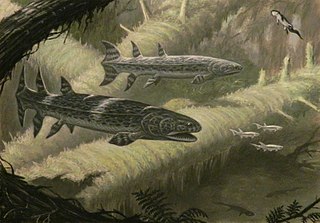
Hyneria is a genus of large prehistoric predatory lobe-finned fish which lived in fresh water during the Famennian stage of the Devonian period.

Lunaspis is an extinct genus of armor-plated petalichthyid placoderm fish that lived in shallow marine environments of the Early Devonian period, from approximately 409.1 to 402.5 million year ago. Fossils have been found in Germany, China and Australia. There are three different identified species of within the genus Lunaspis: L. broilii, L. heroldi, and L. prumiensis.
The Xitun Formation is a palaeontological formation which is named after Xitun village in Qujing, a location in South China. This formation includes many remains of fossilized fish and plants of the Early Devonian period. It was originally referred to as the Xitun Member of the Cuifengshan Formation.

Barameda is a genus of rhizodont lobe-finned fishes which lived during the Tournaisian stage near the start of the Carboniferous period in Australia; fossils of the genus have been reported from the Snowy Plains Formation. The largest member of this genus, Barameda decipiens, reached an estimated length of around 3–4 metres (9.8–13.1 ft), while smallest species, B. mitchelli is estimated to have had a length of about 35 centimetres (14 in).
Heimenia is an extinct genus of prehistoric sarcopterygian or lobe-finned fish.
Westollrhynchus is an extinct genus of prehistoric sarcopterygians or lobe-finned fish containing only one recognized species, Westrollrhynchus lehmanni.
Aglyptorhynchus is an extinct genus of prehistoric marine billfish that was distributed worldwide from the early Eocene to the early Miocene. Fossils are primarily known from the Northern Hemisphere, but one species is also known to have inhabited the waters off New Zealand.

Wuttagoonaspis is an extinct genus of primitive arthrodire placoderm fish from the Middle Devonian of Australia. The box-like skull is up to 18 centimeters in length, and the median dorsal plate averages in length about 10 centimeters. It contains two species: the type species Wuttagoonaspis fletcheri, described by Ritchie in 1973, and Wuttagoonaspis milligani, described by Young and Goujet in 2003.
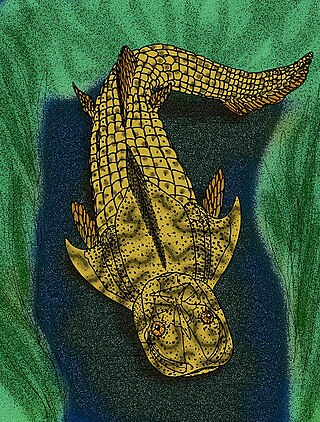
Yiminaspis is an extinct monospecific genus of primitive arthrodire placoderm fish from Emsian-aged marine strata in Yunnan, China. The type species Yiminaspis shenme was named and described in 2008, and is known from a flattened partial skull and portions of the thoracic armor.

Thrinacodus is an extinct genus of basal elasmobranch, found worldwide from the Late Devonian-Lower Carboniferous. The type species is Thrinacodus nanus. Most species are only known from their tricuspid teeth. T. gracia, originally placed in the separate genus Thrinacoselache from the Serpukhovian-aged Bear Gulch Limestone, of what is now Montana, is known from full body impressions, showing a long, slender eel-like body up to a metre in length, with an elongate rostrum. Stomach contents of T. gracia include remains of crustaceans and small chondrichthyan fish. It is a member of the Phoebodontiformes.
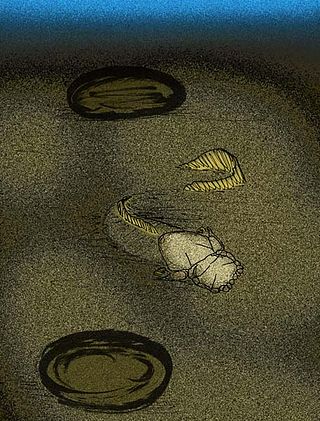
Yurammia is a placoderm from what is now the Pambula River in New South Wales. Unlike all other known phyllolepids, Yurammia's plates had no external grooves.
Cobandrahlepis is an extinct genus of phyllolepid placoderm found in New South Wales, Australia.
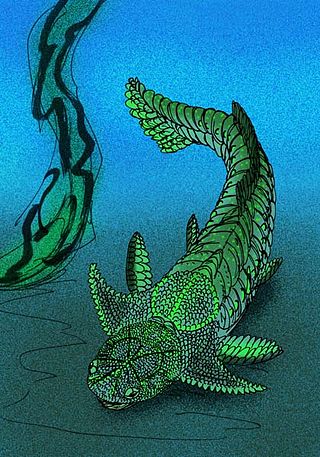
Actinolepis is an extinct genus of actinolepid placoderm from the Early Devonian. Four species are known: A. magna from Estonia, A. spinosa from Latvia, the type species A. tuberculata from New Zealand and A. zaikai from Belarus.
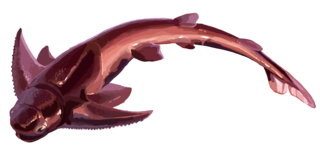
Kujdanowiaspis is an extinct genus of arthrodire placoderm fish from the Early Devonian of Podolia (Ukraine), Poland and Spain. Kujdanowiaspis is known from many fragmentary head shields and body armours.

Sam Giles is a palaeobiologist at the University of Birmingham. Her research combines modern imaging with fossils to understand the evolution of life, in particular that of early fish, and in 2015 "rewrote" the vertebrate family tree. She was a 2017 L'Oréal-UNESCO Rising Star and won the 2019 Geological Society of London Lyell Fund.

Ctenacanthiformes is an extinct order of cartilaginous fish. They possessed ornamented fin spines at the front of their dorsal fins and cladodont-type dentition, that is typically of a grasping morphology, though some taxa developed cutting and gouging tooth morphologies. Some ctenacanths are thought to have reached sizes comparable to the great white shark, with body lengths of up to 7 metres (23 ft) and weights of 1,500–2,500 kilograms (3,300–5,500 lb). The earliest ctenacanths appeared during the Frasnian stage of the Late Devonian, with the group reaching their greatest diversity during the Early Carboniferous (Mississippian), and continued to exist into at least the Middle Permian (Guadalupian). Some authors have suggested members of the family Ctenacanthidae may have survived into the Cretaceous based on teeth found in deep water deposits of Valanginian age in France and Austria, however, other authors contend that the similarity of these teeth to Paleozoic ctenacanths is only superficial, and they likely belong to neoselachians instead.
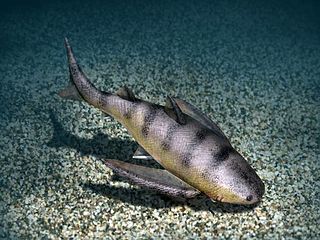
Gyracanthidae is an family of extinct fish belonging to the class Acanthodii, known from early Devonian to late Carboniferous. Members are characterized by large, broad-based, paired fin spines with the pectoral fin spines having a distinct longitudinal curvature. Although it is originally classified in order Climatiiformes, but later study questioned this.

The Mandagery Sandstone is a Late Devonian geological formation in New South Wales, Australia. It is one of several famed Australian lagerstätten, with thousands of exceptional fish fossils found at a site near the town of Canowindra.
Erikaspis is an extinct monospecific genus of arthrodire placoderm fish found in Lochkovian-Pragian deposits of Podolia, Western Ukraine. The type species Erikaspis zychi was originally described in 1945 by Erik Stensiö based on a partial skull-roof, and was named Kujdanowiaspis zychi. In 2007, it was subsequently reassigned to the newly named genus Erikaspis, based on significant differences from Kujdanowiaspis.





















